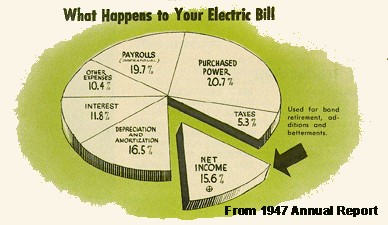Then and Now
On November 8th, 1938 Klickitat County created a brand new public utility district; in 2023 the PUD celebrates its 85th anniversary. A lot has changed in 85 years!
In 1938 the county was a patchwork of electricity providers. Pacific Power & Light, an investor-owned utility headquartered in Portland, served the cities. Small power plants provided power to small communities -- Glenwood, Klickitat, Wahkiacus, and Roosevelt -- but large areas of the county were without electricity.
The power provided by PP&L was expensive and unreliable. The power company's chief interest was making a dividend for stockholders, and there wasn't much profit in maintaining the system or providing lights to farms and rural areas. It would cost too much to string new line and there would be too little return in terms of revenue, or so they thought.
"They really misjudged the farmer," says retired PUD Commissioner Harold Hill. "They didn't foresee that the farmer would make electricity his new hired hand and use it to power pumps and all kinds of engines." Or that the farm wife would put electricity to work inside the home, helping to ease the drudgery of farm chores.
 Then: In 1938 a new federal law established a minimum wage of 25 cents per hour.
Then: In 1938 a new federal law established a minimum wage of 25 cents per hour.
Now: The minimum wage is $15.74 an hour, an increase of over 6,000 percent over 85 years. Compare that with the cost for PUD power over the past eight decades:
Then: In 1942, the first full year the PUD provided electricity, the average cost for power was about 5.5 cents per kilowatt hour (kWh).
Now: The average cost for power for residential and small farm customers is 9.8 cents per kWh. In the past 80 years, the price of power increased only 4.3 cents per kWh.
Then: The average PUD customer used under 100 kWh of electricity per month. (In 1948 General Manager Emmet Clouse reported that there were not more than two dozen electrically-heated homes in PUD territory.)
Now: Our residential and small farm customers use 1,500 kWh a month on average.
Then: The average monthly PUD bill was about $4.00, including a $2.50 minimum charge (which included the first 60 kwh of electricity).
Now: The average monthly residential bill is $168.88 and includes a base fee of $22.33.
Then: In 1941, the year it energized its first line, the PUD had 225 customers and 90 miles of line. That was just 2.5 customers per mile of line -- not a large customer base over which to spread costs.
Now: Today the PUD serves 14,075 customers and has 2214 miles of line. That's 6 customers per mile of line, making the PUD still one of the state's most rural electric utilities.
Then: The PUD's first commissioners were farmers and Grange leaders Martin Lumijarvi from Centerville, M.A. Collins from Bickleton and J.S. Degman from White Salmon.
Now: The PUD's elected commissioners are orchardist Dan Gunkel from Goldendale, retired PUD employee Doug Miller of Goldendale, and businessman Randy Knowles of White Salmon. As the first commissioners did, they meet twice a month to conduct PUD business in open, public sessions.
Then: In 1938 the PUD was the first PUD in Washington to apply to BPA for power from the new federal dams on the Columbia River. The PUD estimated its annual consumption would be 3.6 million kilowatt hours.
Now: In 2022, the PUD customers used 529 million kWh of energy. The PUD McNary Dam fishway project, built with our partners NWPUD, generates about 6 percent of the PUD's annual energy load.